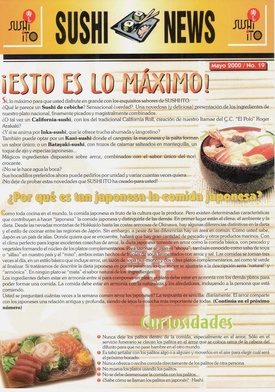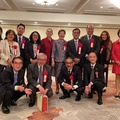“How does ceviche sushi sound? Amazing, right? An innovative (and delicious) presentation of ingredients from our national cuisine, finely chopped and masterfully combined.”

These days, when Nikkei cuisine has become a trademark in Peru, the lines above, aren’t surprising to anyone. But when they were published 22 years ago, it was a very different story.
Although Nikkei cuisine existed, it was not well-known and the reputation it has today was still light years away. At the time, Nikkei and Japanese restaurants were rare in Peru.
Today, sushi is everywhere in Lima, even in restaurants where it isn’t the specialty.
These prescient lines appeared in a newsletter published by Sushi Ito restaurant in May 2000. The restaurant’s chef then and now is Roger Arakaki, a Sansei.
DEKASEGI EXPERIENCE
Becoming a chef wasn’t in Roger’s plans. He was studying architecture at a university in Peru when the economic collapse of the late 1980s motivated him, like thousands of other Nikkei, to emigrate to Japan.
In Japan he learned a lot about Japanese food. Although Roger’s father is Nikkei he had never lived with him,. So he didn’t know much about Japanese dishes and ingredients except for the food that his classmates brought to La Unión, the Nikkei school he attended.
His relationship with Japanese food was not love at first sight. Accustomed to dishes like chicken milanese, fish filets, and fried chicken served by his mother in Peru, Roger didn’t eat very much when he first arrived in Japan.
But gradually the new flavors became more familiar and he started to appreciate them, training his palate over time.
His life took another turn when a former classmate, the owner of a restaurant in Lima, invited him to join as chef. Roger didn’t consider himself a chef yet, but his friend knew that he liked to cook.
Roger accepted her offer, ending the Dekasegi stage of his life, which had lasted about nine years.
LIMA: FROM TRADITION TO FREEDOM

Working at his friend’s restaurant was Roger Arakaki’s first professional experience as a chef.
But he wasn’t starting from zero. He already had some valuable experience from his time in Japan. He had immersed himself in Japanese cuisine, but he had also learned about the restaurant business, thanks to his mother-in-law who provided food service to a dormitory that housed expatriates from various countries.
His first professional destination in Lima was a traditional Japanese restaurant. For the first year and a half, he deepened his understanding of Japanese cuisine and received training in administration and logistics, among other aspects of restaurant management.
From there he went to Sushi Ito in 1999. At the time, Roger recalls, you could count the number of Japanese restaurants in Lima on one hand and fusion was rarely talked about.
At Sushi Ito he had the freedom to create and prepare dishes, with a menu that broke from tradition to explore new ideas. Fusion was beginning to blossom.
From the start, Roger knew his cuisine wasn’t for purists, but rather for the general public. So he came up with dishes adapted to the Peruvian taste and palate.
A restaurant aimed only at the Japanese community would have been a failure, he says. Being flexible was the key.
Embracing heterodoxy—which it was at the time—has worked for Roger, since it appeals to people hungry for innovation, who want something that was different and daring.
Sushi Ito also benefited from the wave of reinvented fusion sushi from the United States, creating something similar but using Peruvian ingredients.
Once Sushi Ito had earned a reputation as a modern restaurant, the innovations continued. Roger recalls that one of his most ground-breaking creations was two-flavor maki, known as “M2S”, with prawns, cheese, and avocado, among other ingredients. Half of the roll is breaded while the other half is wrapped in trout.
After noticing that people wanted two types of maki—fried and traditional (so they had to order both), he added the M2S to the menu to offer both in one roll.
In Roger’s case, creativity is nurtured by observation, travel, research, cookbooks, experimentation (what happens if I do it this way, if I use this ingredient, etc.) as well as his customers (what do they want, what are they looking for). For example, Peruvians love fried food, and as a chef Roger internalized that preference. His radar is always scanning to see what the latest buzz is about.
FUSION WITHOUT EXTREMES
Innovation, modernity and fusion are all wonderful to a certain extent. In general, that’s what Roger Arakaki believes, although he says some lines shouldn’t be crossed. He cites as an example maki with “lomo saltado” (stir-fried beef), which he considers too “extreme.”
Fusion yes, but in moderation, he says. It’s important to know how to appreciate the different flavors and ingredients.
Since Roger started at Sushi Ito at the beginning of this century, Nikkei cuisine has made a great deal of progress, so much that it is now directly related to Peru, even though it could potentially come from other countries. It has become a de facto Peruvian brand.
It’s been a huge wave that brings both the good and the bad. There are restaurants, Roger says, that don’t use Japanese rice, only “Japanese-style rice.” Others use Peruvian rice and their customers aren’t able to tell the difference.
That said, Roger’s rejection of certain supposedly fusion practices doesn’t mean that he is a culinary conservative, as he’s still open to new ideas.
Before the pandemic, he partnered with others to open a Thai restaurant, Lima Thai, and another restaurant serving meat and pasta. Although both restaurants were forced to close because of the pandemic, Lima Thai dishes have survived as part of the Sushi Ito menu.
LEARNING FROM EVERYTHING
In Roger Arakaki’s post-Dekasegi life, teaching has played a central role. As an instructor at the Columbia Institute specializing in Japanese cuisine, teaching has provided an opportunity for him to pass on his knowledge, share with others, as well as to learn.
He took education classes, trained as a teacher and enjoys his classes. “I’ve learned along with the students. Being an instructor has been an amazing learning experience,” he says.
This learning experience has also been beneficial outside the classroom.
The young man who arrived from Japan was “very by the book,” the chef admits. Over the years he has become more flexible, adapting to the different personalities surrounding him in order to be a better manager.
It has been a comprehensive growth experience (from the culinary—now, for example, he values ingredients more than he did when he started out—to working with others), that has transformed him into “a different Roger, more well-rounded.”
That Roger Arakaki, with more experience on his shoulders, has participated in charity events in the United States, where he was honored as a “Bicentennial Chef” by the U.S. Senate, through the organization Peru to the World Expo.
Lastly, he will represent his country in the multilingual program on cuisine organized by Discover Nikkei, which will include chefs from the United States, Brazil, and Peru. It’s a new step up on a rising career for a chef who accidentally found his vocation in Japan.
* * * * *
Combining Culinary Cultures: A Conversation with Nikkei Chefs from Los Angeles, São Paulo, and Lima
Saturday, December 3, 2022 • 3 p.m. (PST)
Join us for a conversation with noted Nikkei chefs—Niki Nakayama of n/naka (Los Angeles, CA, US), Telma Shiraishi of Restaurante Aizomê (São Paulo, Brazil), and Roger Arakaki of Sushi Ito (Lima, Peru).
REGISTER NOW!:
5dn.org/nikkei-chefs
*This program will be presented via Zoom with simultaneous translation in English, Spanish, and Portuguese. Registration is required. Space is limited, so register now!
© 2022 Enrique Higa Sakuda







